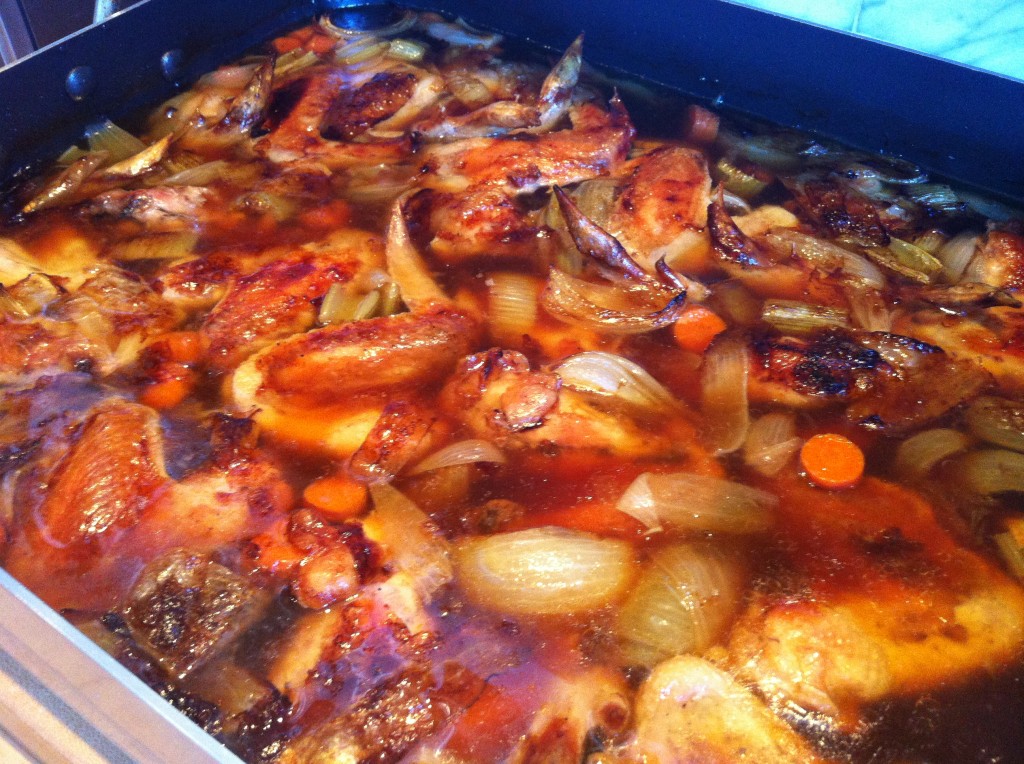It is that time of year when I become stock-centric. The cooler weather, the approaching holidays, the seasonal focus on hearth & home will result in more soups, stews, sauces and braises - the foundation for which is a good stock. I make my own stocks year-round…I have become increasingly incapable of throwing away the carcass from a roast chicken dinner…but, as Halloween passes, my production gets kicked up a notch. I keep an inventory of basic chicken stock, dark chicken stock and beef stock.
♣ ♣ ♣
“A soup like this is not the work of one man. It is the result of a constantly refined tradition. There are nearly a thousand years of history in this soup.”
Willa Cather, ‘Death Comes for the Archbishop’ (1927)
♣ ♣ ♣
Make no mistake…stock is not soup, but Willa Cather’s quote so aptly conveys the evolution of this culinary staple. I think back to when I started making my own stock over twenty years ago & how my own formula has developed. With a subject so seemingly simple, but at the same time so utterly complex, I knew I needed to set the matter of “stock” apart from my weekly recipe roll. In an attempt to do justice to this kitchen workhorse, I consulted the professionals…Thomas Keller, Alice Waters, Nancy Oakes, Barbara Kafka, Larousse…
and discovered that there are as many recipes for stock as there are chefs. From Thomas Keller who, in his book, The French Laundry Cookbook, devotes seven pages to the topic of stock to Larousse who, in the preeminent culinary encyclopedia Gastronomique, sets forth a recipe for white stock in seven sentences.
I have a confession to make here…Thomas Keller scares me. I mean that in the best possible way with the utmost respect. I have been to The French Laundry, multiple times, and have had the best meals of my life. Which, prompted me to buy The French Laundry Cookbook … I have yet to make a single recipe from that book. I have read it cover to cover and with the turn of each page I became more amazed at his seamless pursuit for culinary perfection. More than a bit daunting for the typical chef du jour such as I. I do, however, adopt his first two sentences from that cookbook as my mantra: “When you acknowledge, as you must, that there is no such thing as perfect food, only the idea of it, then the real purpose of striving toward perfection becomes clear: to make people happy. That’s what cooking is all about.” – Thomas Keller. One day, I will, in fact, cook from that cookbook…one day.
Now, back to stock. [ Actually, what I am writing about is technically “broth”. For an in-depth lesson on stock vs. broth, consult Barbara Kafka’s 26-page chapter on stock in her book, Soup: A Way of Life. ] I first learned how to make stock from my Mémère. A frugal woman who cooked & ate A LOT of chicken. The ingredient list was simple: a chicken carcass, an onion, a rib or two of celery and a carrot. Her technique, basic: cover the ingredients with water in a stockpot and boil, skim, simmer & then strain. The aroma that hung in the air on those days she was making stock was as comforting as a warm blanket during a winter storm. I think of her every time my own stock is simmering on the stove.
Basic Chicken Stock
- 2 chicken carcasses
- cold water, enough to cover the carcasses completely
- 3-4 sprigs of fresh thyme
- 1 bay leaf
- 2 large carrots, peeled & cut into one-inch lengths
- 1 leek, cleaned, halved & sliced
- 1 large (or 2 medium) yellow onion, quartered
[ Note: stock recipes often include a rib or two of celery as well as some fresh parsley. Over the years, I have found that both the celery and parsley impart a bitterness that I do not care for so I no longer include. ]
- Place the chicken carcasses in a large stockpot & cover completely with cold water. Bring to a boil over high heat, skimming off foam.
- Make a bouquet garni by placing the thyme & bay leaf in a small piece of cheesecloth & tie up with kitchen string.
- Add bouquet garni, carrots, leek & onion to the stockpot and return to a boil, skimming off foam once again.
- Decrease heat to maintain a simmer (small intermittent bubbles breaking the surface of the liquid) for 4 hours.
- Strain liquid through a fine mesh sieve (or a colander lined with cheesecloth) into a large bowl and let cool completely. Transfer to smaller containers (I use plastic containers that can hold 4 cups/1 quart of liquid). Refrigerate covered for up to three days or freeze for up to three months. Refrigerated or frozen stock should be brought to a boil before using.
♣ ♣ ♣
A couple of years ago, a good friend gave me Boulevard: The Cookbook, as a gift after we enjoyed a phenomenal dinner at this San Francisco restaurant. From this cookbook I learned about making a darker, richer stock by roasting chicken pieces and then simmering them in a lighter chicken stock. The result was extraordinary and I now find that this is the chicken stock I most often use. In fact, I continue to make my basic chicken stock just to feed this heartier version.
- 6 lbs. whole, organic chicken wings
- 5 tablespoons canola oil
- salt & pepper
- 2 carrots, peeled and cut into one-inch lengths
- 2 yellow onions, quartered
- 12 cups of Basic Chicken Stock
- Preheat oven to 450°
- In a large, deep roasting pan (large enough to hold the wings in a single layer) add 3 tablespoons of the oil & the wings. Lightly salt & pepper the wings.
- Roast the wings, turning once or twice for 1 hour.
- Meanwhile, toss the carrots and onions with the remaining 2 tablespoons of oil and add to the wings after they have been roasting for an hour.
- Return pan to oven and continue to roast for 1 hour.
- Add stock to roasting pan, scraping up browned bits from bottom of pan. Decrease oven temperature to 350° and continue to cook until chicken meat is falling from the bone…about another hour.
- Remove roasting pan from the oven and strain through a fine-mesh sieve (or a colander lined with cheesecloth) placed over a bowl. Cool completely & discard fat which has accumulated on top of the stock.
- Transfer to smaller containers (I use plastic containers that can hold 4 cups/1 quart of liquid). Refrigerate for up to three days or freeze for up to three months. Stock should be returned to a boil before using.
♣ ♣ ♣
Beef Stock
- 6 tablespoons canola oil
- 3 lbs. beef oxtail pieces
- 4 lbs. beef shank, two-inch pieces
- 1 large (2 medium) yellow onion, peeled & quartered
- 2 large carrots, peeled & cut into two-inch pieces
- 3 Roma tomatoes, halved
- 4 cloves of garlic, minced
- 8 thyme sprigs
- 2 bay leaves
- 3 tablespoons tomato paste
- 8 cups Dark Chicken Stock
- 4 cups water
- Preheat oven to 450°
- In a large, deep roasting pan add half of the oil, meat bones, onion, carrots, tomatoes & garlic. Drizzle the remaining oil over the contents of the roasting pan. Roast in the oven for one hour, turning ingredients once or twice.
- Remove pan from oven and transfer bones & vegetables to a large stockpot. Place roasting pan over a burner on the stovetop and add 1 cup of the Dark Chicken Stock. Heat to a simmer, scraping up browned bits on the bottom of the pan. Whisk in tomato paste until fully combined. Transfer this liquid to the stockpot.
- Add the remaining Dark Chicken Stock and the water to the stockpot, making sure that the bones and vegetables are covered by liquid (by two inches). Wrap the thyme sprigs and bay leaves in a small piece of cheesecloth & tie with kitchen string to make a bouquet garni. Add bouquet garni to the stockpot.
- Bring contents of the stockpot to a boil. Skim off any accumulated foam and then lower heat to maintain a simmer (small intermittent bubbles breaking the surface of the liquid) for 7 hours. Check the level of the liquid in the pot every two hours (and skim any foam), adding more water if necessary to keep the contents covered by two inches.
- Strain through a fine mesh sieve (or a colander lined with cheesecloth) into a large bowl. Let cool completely.
- Transfer to smaller containers (I use plastic containers that can hold 4 cups/1 quart of liquid). Refrigerate for up to three days or freeze for up to three months. Stock should be returned to a boil before using.



